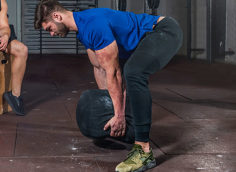The Leg-Raise Chest Press
The exercise improves bench press technique and horizontal pressing mechanics. Here are several of my clients, including NFL athletes Jarius Wynn, Michael Montero, and Jake Banta, demonstrating a few variations:
- Learning to drive with the hips and legs during chest presses is an essential component for maximizing force production and pressing mechanics. However, many lifters lack the ability to fully engage their upper body musculature and rely excessively on their legs to help press the weight up.
As a result, the stimulus to their chest, shoulders, and triceps is minimal. Using the leg raise during chest presses resolves this. It helps to isolate the upper body by eliminating the assistance of the legs. This is also the grand equalizer of all bench press protocols as it's a true indication of upper body strength.
- Periodically isolating the upper body pressing muscles helps create a stronger muscle-mind connection. Once these enhanced neural connections are grooved into your CNS, transferring these improved activation patterns back to standard bench presses will result in increased pressing power.
- You'll notice increased hypertrophy to the chest, shoulders, and triceps. The amount of intramuscular tension and metabolic stress will be significantly greater than you'd typically find with standard bench presses.
- You'll experience increased activation of the core and surrounding stabilizers. The increased recruitment will greatly improve your motor control, balance, and stability. Once you return to standard chest pressing, you'll feel unusually locked in with your mechanics.
- Learning to fire the core and avoid excessive lumbar arch during bench presses is a struggle for many lifters. Over-arching the lumbar spine during the bench is a surefire way to both injure your low back and eliminate the growth-inducing stimulus of the chest press itself. Using the leg raise position eliminates the problem as the core must work overtime to stabilize the spine and pelvis by keeping them neutral.
- Because you don't have a firm foundation for your legs, your body is in a fairly unstable position while lying on the bench. Excessive momentum, shifting, asymmetrical pressing, or cheating can easily result in loss of balance. As a result, you're forced to eliminate compensation patterns and rely on crisp, smooth motions to complete the exercise. This means more tension to the targeted muscles and less tension on the joints.
Both methods involve a straight-leg, ankle-dorsiflexion position:
- Elevate the legs 4-8 inches above the height of the torso. This creates more tension on the core musculature. However, this can cause stress to the lumbar spine with lifters who suffer from low back issues, as there can be excessive arching.
- Use a hollowed body leg raise hold. Elevate the legs 12-18 inches above the height of the torso. While the overall tension to the core is reduced due to better leverage, elevating the legs slightly higher allows you to hollow the core and midsection. You'll be pulling the low back into the pad/floor and keeping the lumber spine in a more neutral position without exaggerated arch. This works great for lifters who struggle with excessive low-back arch.




